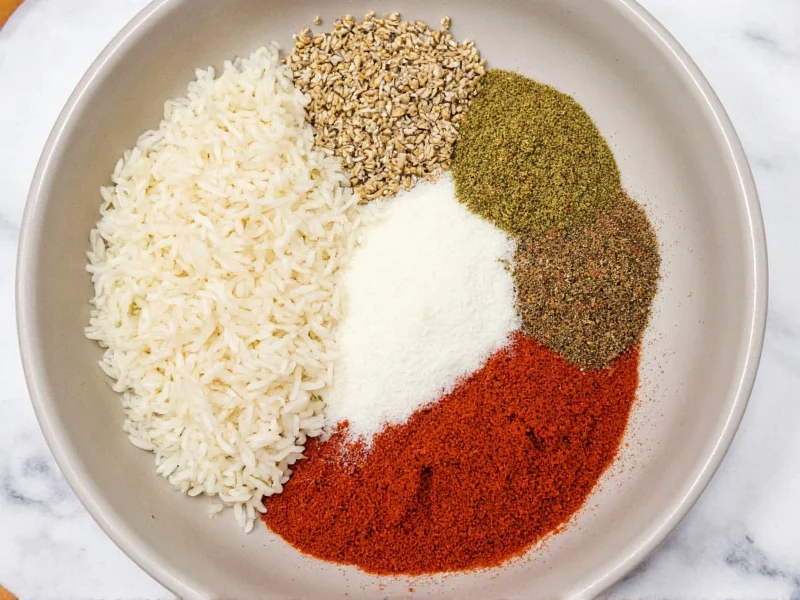Seasoning rice properly transforms this humble staple from bland to extraordinary. Whether you're preparing a simple side dish or crafting a complex main course, understanding how to enhance rice with the right flavors makes all the difference in your culinary results. This guide reveals professional techniques and ingredient combinations that elevate everyday rice into something memorable.
Core Principles of Rice Seasoning
Effective rice seasoning follows three fundamental principles: balance, timing, and cultural authenticity. The best herbs for seasoning rice complement rather than overwhelm the delicate grain. Adding seasonings at the right stage—during cooking versus after—dramatically affects flavor absorption. Understanding traditional rice seasoning techniques from various cuisines ensures authentic results whether you're making Spanish paella, Japanese gohan, or Middle Eastern pilaf.
Essential Seasoning Categories
Rice seasoning falls into five primary categories, each serving a specific purpose in flavor development:
| Category | Purpose | Top Recommendations |
|---|---|---|
| Foundation | Basic flavor enhancement | Salt, pepper, bay leaves |
| Aromatics | Complex fragrance profile | Garlic, onion, ginger, scallions |
| Herbs & Spices | Cultural flavor identity | Cumin, turmeric, saffron, cilantro |
| Acid Components | Brightness and balance | Lemon juice, rice vinegar, tamarind |
| Umami Boosters | Depth and savoriness | Soy sauce, fish sauce, mushroom powder |
Best Seasonings by Rice Variety
Not all rice varieties respond equally to the same seasonings. Understanding how to season white rice properly requires matching flavors to specific grain characteristics:
Long-Grain White Rice (Basmati, Jasmine)
These delicate grains shine with subtle seasonings. For basmati rice seasoning, try cardamom pods, whole cloves, and a cinnamon stick added to the cooking water. Jasmine rice benefits from lemongrass stalks and kaffir lime leaves. Healthy seasonings for rice enthusiasts include toasted sesame oil and rice vinegar for Asian preparations.
Medium-Grain Rice (Calrose, Arborio)
These slightly stickier varieties handle bolder flavors. Saffron threads create authentic Spanish paella, while a combination of garlic, paprika, and parsley works beautifully for everyday preparations. When seasoning rice for meal prep, medium-grain rice holds flavors exceptionally well through reheating.
Short-Grain Rice (Sushi Rice, Sticky Rice)
Traditional Japanese sushi rice requires a specific vinegar-sugar-salt mixture. For quick ways to flavor rice without overpowering its natural sweetness, try a light sprinkle of furikake (Japanese seasoning blend) after cooking.
Regional Seasoning Traditions
Cultures worldwide have perfected rice seasoning techniques over centuries:
- Mexican: Cook rice with tomato broth, cumin, and epazote for authentic flavor
- Indian: Whole spices like cardamom, cloves, and bay leaves create fragrant biryani rice
- Japanese: Season cooked rice with seasoned rice vinegar for sushi preparation
- Middle Eastern: Toasted vermicelli noodles and turmeric create golden rice
- Caribbean: Coconut milk and thyme transform plain rice into something special
Timing Matters: When to Add Seasonings
The moment you introduce seasonings dramatically affects flavor penetration:
- During cooking: Whole spices, salt, and aromatics added to cooking water infuse throughout the grain
- After cooking: Fresh herbs, citrus zest, and delicate oils should be folded in after rice finishes cooking
- Before cooking: Toasting rice with spices in oil (like Mexican rice) creates deeper flavor foundations
For seasoning jasmine rice specifically, add lemongrass and kaffir lime leaves to the cooking water, then finish with fresh cilantro and a squeeze of lime after cooking. This two-stage approach maximizes flavor complexity.
Avoiding Common Seasoning Mistakes
Even experienced cooks make these rice seasoning errors:
- Over-salting: Add half the salt during cooking, then adjust after
- Adding delicate herbs too early: Fresh cilantro or parsley loses vibrancy when cooked too long
- Ignoring acidity: A splash of vinegar or citrus brightens heavy seasonings
- Mixing incompatible flavors: Avoid combining strong competing spices like cumin and saffron
When seasoning rice without salt due to dietary restrictions, boost flavor with mushroom powder, nutritional yeast, or roasted garlic puree for satisfying umami depth.
Professional Tips for Perfectly Seasoned Rice
Master these techniques for restaurant-quality results at home:
- Toast raw rice with aromatics before adding liquid for deeper flavor development
- Use broth instead of water for instant flavor enhancement
- Add a strip of kombu (dried kelp) to cooking water for natural umami
- Let cooked rice rest covered for 10 minutes before fluffing and adding final seasonings
- For best spices for fried rice, season the rice the day before cooking for optimal texture and flavor absorption
Creating Balanced Flavor Profiles
The most memorable seasoned rice achieves harmony between five taste elements:
- Saltiness: From salt, soy sauce, or fish sauce
- Sweetness: Natural grain sweetness or added sugar
- Sourness: From citrus or vinegar components
- Bitterness: Subtle notes from certain spices or herbs
- Umami: Savory depth from mushrooms, tomatoes, or fermented ingredients
Adjust these elements to create seasoning profiles that complement your main dish rather than compete with it.











 浙公网安备
33010002000092号
浙公网安备
33010002000092号 浙B2-20120091-4
浙B2-20120091-4